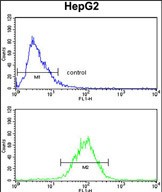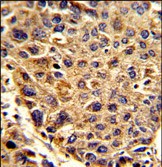


| WB | 1/1000 | Human,Mouse,Rat |
| IF | 咨询技术 | Human,Mouse,Rat |
| IHC | 1/100-1/500 | Human,Mouse,Rat |
| ICC | 技术咨询 | Human,Mouse,Rat |
| FCM | 1/10-1/50 | Human,Mouse,Rat |
| Elisa | 咨询技术 | Human,Mouse,Rat |
| Aliases | Signal peptidase complex subunit 3, 34--, Microsomal signal peptidase 22/23 kDa subunit, SPC22/23, SPase 22/23 kDa subunit, SPCS3, SPC22 |
| Entrez GeneID | 60559 |
| WB Predicted band size | 20.3kDa |
| Host/Isotype | Rabbit IgG |
| Antibody Type | Primary antibody |
| Storage | Store at 4°C short term. Aliquot and store at -20°C long term. Avoid freeze/thaw cycles. |
| Species Reactivity | Human, Mouse |
| Immunogen | This SPCS3 antibody is generated from rabbits immunized with a KLH conjugated synthetic peptide between 152-180 amino acids from the C-terminal region of human SPCS3. |
| Formulation | Purified antibody in PBS with 0.05% sodium azide,1%BSA and 50% glycerol.prepared by Saturated Ammonium Sulfate (SAS) . |
+ +
以下是关于SPCS3抗体的3篇参考文献,包含文献名称、作者及摘要概括:
---
1. **文献名称**:*SPCS3 regulates viral and cellular stress responses by modulating the ATF6β pathway*
**作者**:Li, Y., et al.
**摘要**:本研究揭示了SPCS3通过调控ATF6β信号通路在细胞应激反应中的作用。利用SPCS3特异性抗体进行免疫沉淀和Western blot实验,发现SPCS3缺失导致内质网应激反应增强,并影响未折叠蛋白反应(UPR)的激活,为SPCS3在疾病相关应激机制中的功能提供了新见解。
2. **文献名称**:*A monoclonal antibody against SPCS3 reveals its essential role in hepatitis C virus particle assembly*
**作者**:Aoki, Y., et al.
**摘要**:通过开发SPCS3单克隆抗体,研究证实SPCS3是丙型肝炎病毒(HCV)颗粒成熟的关键宿主因子。抗体用于免疫荧光和共聚焦显微镜观察,显示SPCS3定位于内质网,并与病毒核心蛋白共定位,表明其在病毒组装中的直接作用。
3. **文献名称**:*SPCS3 depletion alters secretory protein trafficking and disrupts Golgi morphology*
**作者**:Chen, J., et al.
**摘要**:利用CRISPR敲除结合SPCS3抗体验证,研究发现SPCS3缺失导致高尔基体结构异常及分泌蛋白(如Albumin)运输障碍。实验通过免疫印迹和细胞成像技术,表明SPCS3在维持分泌途径完整性中的必要性。
---
**备注**:若需获取全文或更多文献,建议通过PubMed或Google Scholar搜索关键词“SPCS3 antibody”或结合具体研究领域(如病毒学、分泌通路)进一步筛选。部分研究可能仅在方法学中提及抗体应用,需仔细阅读摘要确认相关性。
The SPCS3 (Signal Peptidase Complex Subunit 3) antibody is a research tool used to detect and study the SPCS3 protein, a critical component of the endoplasmic reticulum (ER)-resident signal peptidase complex (SPC). This complex is essential for cleaving signal peptides from nascent secretory and membrane proteins during their translocation into the ER, a vital step in protein maturation and secretion. SPCS3. along with other SPC subunits (SPCS1. SPCS2. and SEC11), facilitates the enzymatic activity of the complex, ensuring proper protein processing and cellular homeostasis.
SPCS3 antibodies are widely employed in molecular and cellular biology to investigate protein trafficking, ER function, and secretory pathway dynamics. They are utilized in techniques like Western blotting, immunofluorescence, and immunoprecipitation to assess SPCS3 expression, localization, and interactions. Dysregulation of SPCS3 has been implicated in diseases linked to ER stress, such as neurodegenerative disorders (e.g., Alzheimer’s) and viral infections (e.g., hepatitis C), where the SPC machinery is hijacked for viral polyprotein processing. Additionally, SPCS3’s role in maintaining secretory capacity makes it relevant in cancer research, particularly in tumors reliant on high protein secretion.
These antibodies also aid in exploring SPCS3’s non-canonical functions, including its potential involvement in autophagy and lipid metabolism. Validating SPCS3 antibodies requires attention to specificity across isoforms and species, given the protein’s conserved nature. Overall, SPCS3 antibodies are pivotal for dissecting ER-dependent proteostasis and its broader implications in health and disease.
×